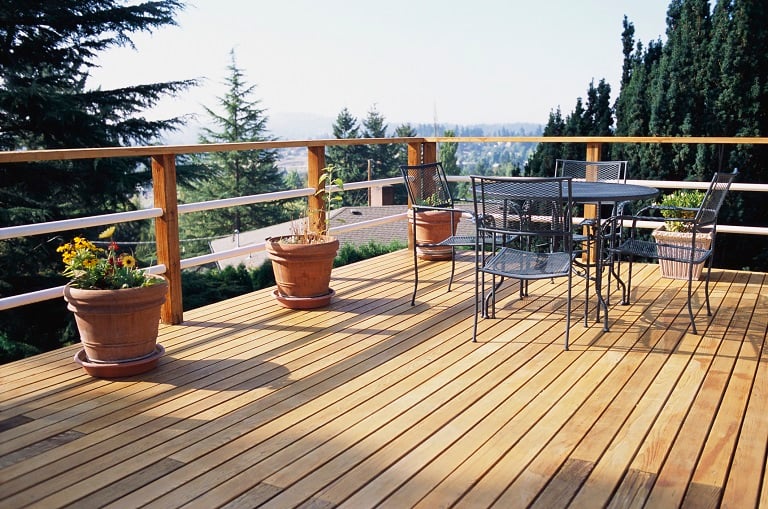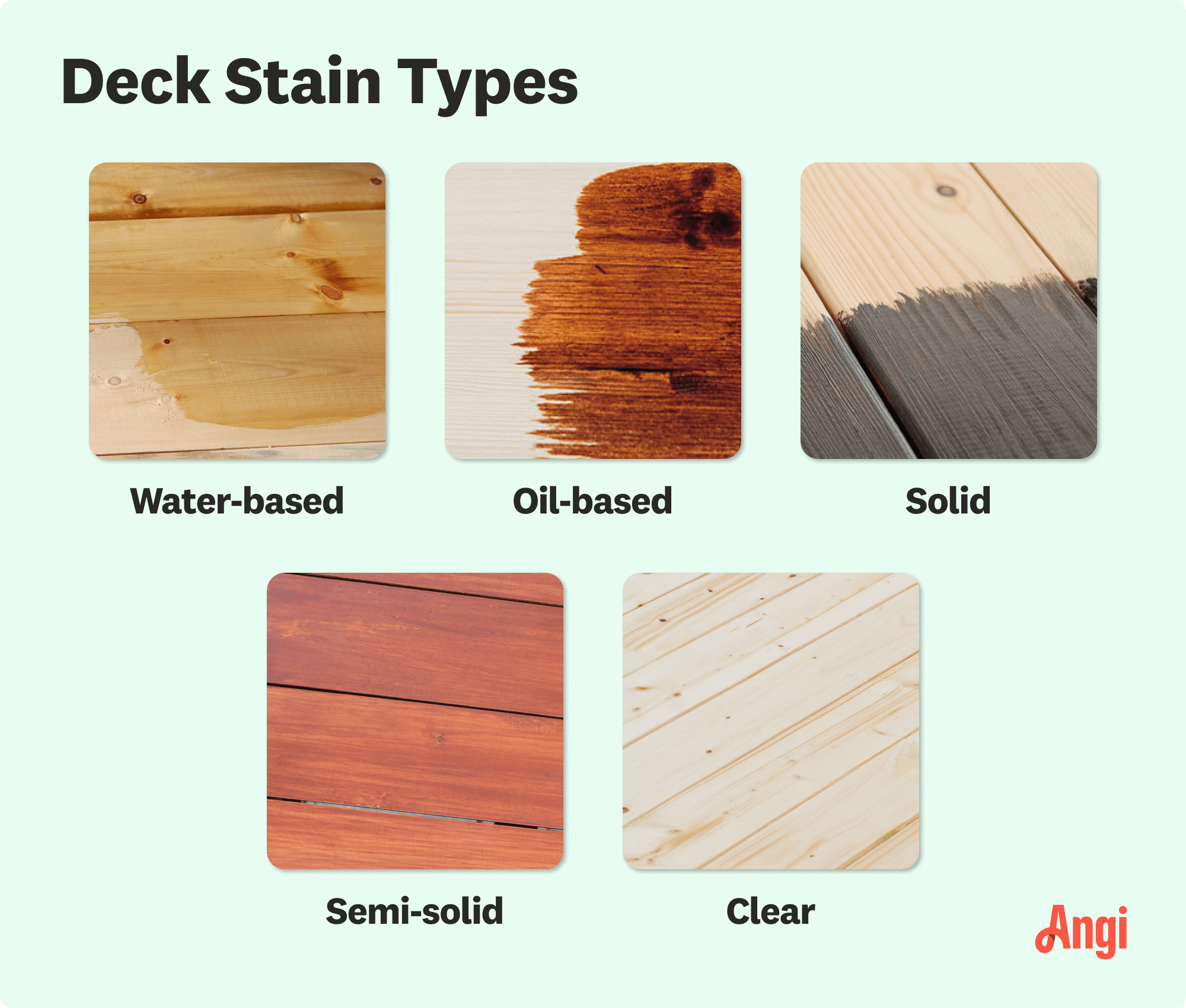
The cost to stain cedar siding largely comes down to the labor required. Learn how you can keep your costs down for materials, and when hiring a pro.
Don’t abstain from this project for too long


Late spring and early fall are typically the best times to stain a deck.
Stain your deck every few years to keep it looking its best and protect it from the elements.
Fading, cracking wood that’s absorbing water readily likely needs restaining.
Pick a dry day when temperatures are mild and the deck isn’t in direct sunlight.
It’s disheartening to watch your beautiful deck lose its luster with age. Staining is an excellent alternative to painting your deck that helps protect it from the elements. However, you have to keep up with regular maintenance to keep your deck stain looking its best.
So, how often should you stain your deck, and when should you bust out the brushes? Generally, you should schedule deck staining every two to three years, picking a mild, dry, and not overly sunny day. Learn more about the best time to stain a deck and why you should avoid staining during certain times of the year to ensure your deck is always in tip-top shape.

A new deck should be seasoned (left alone to dry out) for about 30 days before staining, but that timeframe can vary based on the materials used. You should give pressure-treated lumber at least six months to season before applying a stain. Kiln-dried lumber (most common) needs one to two months, and green lumber (just-cut wood) needs to dry out for one year per every inch of thickness before being stained.
The best season for staining your deck will depend on where you live. Ideally, you want a cloudy, dry, calm day when temperatures are between 50 and 90 degrees Fahrenheit and humidity is low. If you want to stain your deck soon, you have two safe timeframes.
If you want to spruce up your deck in time for summer soirees, you could tackle the task as the days get drier and warmer in late spring. Just be sure to avoid any April showers or random frosty days in your region.
When autumn arrives, it’s often the perfect time to stain a deck. However, you’ll want to get in there before the frigid temperatures and damp winter conditions arrive. If you’re still lucky enough to get warm weather and plenty of sun in the fall, consider staining in the early morning before the hottest part of the day. Hot, direct sunlight can evaporate the deck stain before it fully absorbs into the wood.
Always check the forecast. You want the deck to be fully dry for at least 24 hours before you start staining. The stain won’t stick well to damp wood, and it needs dry weather for a couple of days after staining to allow it to cure fully.
To ensure you reap the best results from staining your deck, you need to understand how your climate may impact the results. The ideal temperature for deck staining is between 50 and 90 degrees. This will depend on where you are located, so take this temperature into account when you plan. Another climate factor to consider is whether you are in a high or low humidity zone, as humidity levels can affect the drying process and how the stain penetrates into the wood.
Not surprisingly, weather conditions are one of the most prominent issues to consider when staining your deck, so always check the weather before you begin. Favorable weather will help the stain set properly and absorb evenly. Also, mild and dry conditions ensure that the stain dries consistently.
A good rule of thumb: Don’t stain your deck if the temperature is over 90 degrees, as the excessive heat can cause rapid drying and uneven stain quality. If you need to stain in hot weather, try working in the early hours of the day, setting up portable shade, or using a tarp to block some of the direct sunlight.
Likewise, wintry weather can also cause improper drying. If you stain your deck in winter, refrain from doing so when it’s snowing or raining. Inclement weather causes added moisture, which can interfere with the stain penetrating the wood. The precipitation can also wash away the staining, resulting in a loss of money and time.

Beyond choosing the shade or hue of stain, there are types of stain that maximize the results of your deck project. Oil-based stains are more difficult to work with but last longer and are more durable than water-based stains.
Beyond that, you’ll find four varieties of deck stains:
Transparent: Clear or with a slight tint that promotes the natural grains of your wood.
Semi-transparent: A slightly colored stain that showcases the beauty of natural wood.
Semi-solid: A stain with more concentrated pigment that disguises imperfections like age and weather decay.
Solid: A rich and opaque pigment that provides lasting and full coverage to cover decay, worn wood, and cracks.
If you want to retain the wood's natural tone and texture, choose transparent or semi-transparent varieties. However, if your goal is to color the deck, a semi-solid or solid deck stain is the best choice.
If you are staining during spring and summer months, opt for a semi-solid or solid deck stain, which can provide a barrier for moisture protection. These types are also better if your deck is less than five years old, as they can preserve the wood against weather agents.
Wood decks are easy to stain and can enhance their longevity and appearance. Just apply the stain in the direction of the grain using a clean cloth or brush, and re-stain when dry.
However, if you have a composite deck, you likely cannot apply a stain. You can possibly stain it if the deck is older and uncapped. But newer composite decks have a polymer cap that prevents the material from rotting.
When planning your deck staining project, the best time of day is to start in the morning. The temperature is cooler, and the wood’s surface is least affected by humidity or extreme heat, which can disrupt the stain's penetration and drying.
Before we dive into when you shouldn't stain your deck, it's important to note that these rules aren't absolute. They depend on many factors, like your location, but they offer some guidance as to why winter and summer aren’t the best times to stain your deck.
Winter isn't the best time to stain a deck, even if you don’t have a layer of snow covering the boards. While you can apply some oil-based types of exterior wood stains in temperatures as low as 35 degrees Fahrenheit, freezing conditions prevent efficient curing. Plus, these oil-based options take up to 48 hours to dry, making planning during the snowy season difficult.
It’s not unusual for spring to start damp. Wet wood doesn’t absorb stain well, so it’s best to wait for the weather to dry up and humidity levels to decrease before breaking out the stain. Spring winds can be a nuisance for your project, too. They can blow leaf litter and other debris onto the deck—not ideal if you’ve just put down a coat of sticky stain.
Why wouldn’t you want to do outdoor DIY jobs when the sun is shining? It may seem like a good idea, but hot, direct sun dries the stain out before the wood fully absorbs it. Dried out, partially absorbed stain can lead to unsightly watermarks, and the stain won’t do its job effectively. If you do this work in the summer, you might have to apply more stain sooner than every two or three years, so it’s best to stick to sunning yourself on the deck instead.
If you don’t want to get stuck inside during the summer, pick an overcast day or break out a canopy to provide shade for your deck staining project.
Deck staining costs typically fall from $550 to $1,250, averaging $850. The price per square foot for deck staining ranges from $1 to $2.50. The primary determinant of staining expenses is the deck's size, with smaller decks, around 100 square feet, costing around $100 to $250 for materials, excluding labor charges.
If your deck exceeds 500 square feet in size, engaging the services of a pro may result in expenses reaching up to $2,500. Remember that your exact out-of-pocket costs will vary based on your location.
Although professionals recommend restaining your deck every two to three years, much depends on your climate, deck material, and footfall. Restaining isn’t just about upping your curb appeal, either. Leaving your deck too long between restaining can expose the wood to problematic pests, moisture, and UV rays, leading to permanent deck damage.
Rather than sticking to a strict schedule, watch out for these signs that your deck needs staining.
Over time, the sun’s rays will dull and fade the finish of your wood, even when there’s a layer of stain. If you live in a hot, dry region, you’ll likely see this phenomenon happen sooner than it does in rainy, humid climates.
If you spill water on the deck and it soaks into the wood rather than beading on the surface, it’s likely a sign that the waterproofing qualities of the stain are diminishing.
Splintering, warping, and cracking deck boards are signs that moisture is getting into the wood. When boards have severe cracks, rot may have set in, and you should replace the boards before applying a new waterproof stain to the deck.
If you notice peeling, uneven layers on the surface of your deck, the old stain could be lifting off the lumber. Not only is it not the nicest to look at, but it also means that moisture may be getting into the wood.
Mold and mildew can still build on top of a deck stain, but if they’re forming more quickly than normal and are difficult to clear away, it could be because the stain is rubbing off.
After a fresh deck stain application, sweeping and mopping your smooth deck should be a breeze. When the stain surface lifts, dirt and dust stubbornly cling to the wood surface.
Even if it’s a job that only comes around every few years, when it’s time to stain your deck, you might not relish attempting this back-breaking task yourself. Hiring a local deck staining company means they’ll pick the best time to stain the deck and ensure good coverage.
The pros can also inspect the deck and make timely repairs before they become more costly and complex. A thorough job done by professionals can be the difference between restaining in one year or three.
From average costs to expert advice, get all the answers you need to get your job done.

The cost to stain cedar siding largely comes down to the labor required. Learn how you can keep your costs down for materials, and when hiring a pro.

Looking to give your fence a refresh? This guide explores the cost to stain a fence—and the cost to paint it, too— so you can budget for your project.

Painting your house increases curb appeal and durability, but you may need to rent a lift for the project. Here’s a breakdown of cost by lift type and height.

Breathe new life into your deck by sanding it before adding stain. Follow this guide to learn how to sand a deck and choose the right grit sandpaper.

If you’re wondering how often to paint your house exterior, you’re in the right place. Chips, cracking, or fading are all signs it needs some TLC.

Can you paint vinyl siding? The good news is, yes, you can—but there are things you should know first. Learn about the pros and cons of painting vinyl siding and if it's the right project for you.